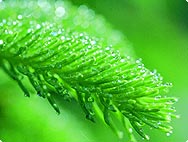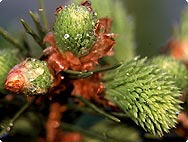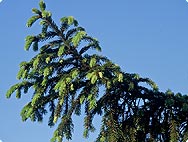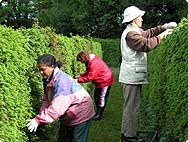A.Vogel search
When the internal search is activated, personal data such as your IP address is transmitted to our search engine Cludo. Data is thus transferred to a third country. Please click here if you want to display the internal search. You can find more information on data protection here: Privacy policy.
A.Vogel plant encyclopaedia
Picea abies (L.) KARST.
Norway spruce, Pine
History

The generic name Picea comes from the Greek words peuca, peuch and pissa from which the Latin term pix meaning “tar” was derived; this refers to pine resin obtained by tapping the trunks of the trees. The common names spruce and red pine refer more to the species Picea and and white or silver pine or fir respectively to the species Abies which are all comprised in the term “pine trees”. The pine tree was highly regarded centuries ago by the Celts. The tree was a part of the Celtic calender from 2 to 11 January and again from 5 to 14 July; the winter solstice on 21 December was dedicated both to the vowel “A” (known as Ailm) and to the silver pine tree. After this date, the days begin to get longer once again and for this reason the pine is associated with the birth of light.
Middle Age herbals differentiate between spruce, silver pine/fir and larch, but their usage was summarised together. According to Lonicerus: “Steeped pine leaves soothe infected wounds and are good for toothache; with honey they are to be given to those suffering from afflictions of the liver. Boiled with honey, pine resin is good for the head-flow (i.e. colds) and sore throat, also known as angina. It is also soothing for all external ailments to the body. Turpentine gently purges afflictions to the chest and is healing and cleansing to the lung and liver. Carefully prepared and washed, turpentine is particularly good for consumption (tuberculosis), for persistent coughs, whooping coughs and suppurating discharge of blood typical for vomit during consumption.”
Botanical characteristics

Red pine or spruce is an evergreen tree growing to height of up to 60 metres with a pyramid-shaped crown and a slim, straight trunk often branching out right down to the ground. It belongs to the conifer family. Pine trees have shallow roots – which is often their downfall during storms. The bark is reddish brown and becomes more flaking and ribbed as the tree ages. The branches hang downwards and the tips point upwards; they are either covered all around or just on the side exposed to light with dark green, square-edged, sharply pointed needles. Deer like to eat pine branches, but even more they love those of the white pine.
The pine does not bloom until its thirtieth year, putting out both male and female flowers in May. The unripe male catkins are about the size and colour of a strawberry and are usually to be found in between the needles of last year’s branches. As they ripen, they are coloured yellow by the many pollen seeds. The small female cone blossoms are to be found at the tips of the branches and are bright carmine in colour. When ripe, they turn brown and fall off whole from the tree. In the same year, pine cones begin to ripen in the tree’s crown, standing upright at first and hanging down later. These grow to a length of between 10 and 15 cm and a width of 3 to 4 cm.
Pine trees can live for up to 600 years. Nowadays however, their longevity is endangered by pollution, increasing amounts of ozone in the atmosphere, acid rain as well as increased soil acidity and lack of moisture. Conifers are more susceptible to these factors than deciduous trees, because they do not loose their needles on an annual basis. When pine trees begin to feel threatened by unknown invaders they create “stress substances” such as picein and piceol [1].
The tree blooms in May.
Habitat

Pine trees are indigenous to Central Europe and the far north. They appear in southern climes only as far as the 40th degree of latitude. In the east the pine is restricted by the river Volga. The tree is to be found in mountainous areas up to a level of 900 metres and often grows alongside all manner of deciduous trees. Spruce is widely cultivated in lowland areas where it has almost displaced the fir/silver pine.
Preparation

A.Vogel/Bioforce makes use of the pine’s essential oil, an aqueous extract and the juice obtained from fresh spruce tips, plucked in spring either from spruce growing in the wild or from organically controlled plantations. In order to obtain the extract, fresh buds are placed in cold water in a vacuum and simmered at a temperature of approximately 40º C, after which they are cooled and filtered. This extract is then gently boiled down according to a traditional recipe in a vacuum with unrefined sugar cane, pear extract and honey until a syrup is obtained.
For the aqueousextract, 1 to 2 finely chopped fresh pine tips are soaked in cold water for a period of between 6 to 8 hours, then heated but not brought to a boil, allowed to simmer for 10 minutes and then sweetened with rock candy or honey. An extract of young pine tips and needles are used in the USA to make a beverage known as “Spruce Beer”. Sugar syrup or molasses, water and other ingredients are added to the pine extract which is then fermented with yeast [2]. There are also medicinal uses for a mother tincture of spruce, pine essence and pine oil, pine resin, pine rosin, turpentine oil, balsam, salve and tar.
Pine is used extensively to make furniture, organs and other instruments (Stradivaris are made from pine wood) as well as for sounding boards; it is also used for building or burning; in the paper industry, for telegraph poles, tar, coal and tanbark. The resin is used to make turpentine, rosin and tar.br